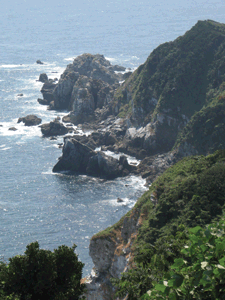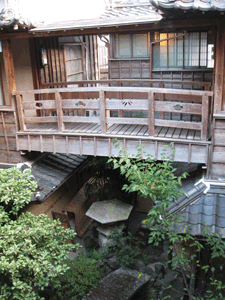Ise-Shima National Park 伊勢志摩国立公園
|
We know what you’re thinking: Ise-Shima, off the beaten path, really? We must be joking. After all, 6.5 million visitors disembark at Ise every year to pay their respects at the shrine of Amaterasu, the great ancestral goddess of the Imperial Family. Japanese have journeyed to Ise for thousands of years. On weekends, the forested grounds are packed with pilgrims and tourists, and on holidays the crowds can reach legendary proportions. Few paths are more beaten than the road to Ise. But most follow a strict and hyper-efficient visitation schedule: they visit the shrines, pray, and chow down on the local cuisine: Ise lobster, perhaps, or a bowl of dark-sauced udon with akafuku sweets for dessert. Fully sated, they hop back on their tour buses to journey onward, presumably to more attraction-dense areas like Kyoto or Nara. Few stay longer to explore the historic neighborhood of Kawasaki and the tiny island of Kamishima.
Kawasaki (河崎) Walking from Ise-shi station in the opposite direction from the shrines, you’ll reach Kawasaki in about ten minutes. Entering the neighborhood is a bit like stepping through a time warp. Running parallel to the Seta River (勢田川) canal is a stretch of old merchant houses and kura (old warehouses) that evoke the bygone Edo era. Kawasaki first developed as a wholesale supply center, capitalizing on the tourist trade of the nearby shrines by selling stocks of sugar, salt, alcohol, rice and other food staples, in addition to more specialized products like lacquerware and wooden craft objects. Although many of the old merchant houses have become private museums, the neighborhood is no mere fossilized historical showpiece. Some of the heritage buildings are still very much in use, including a 17th century katsuobushi (dried bonito) business, a store selling traditional Japanese geta and zori sandals, a confectionary specializing in sweet Itoin rice crackers, and a charming ryokan that prides itself on its macrobiotic meals. (The ryokan, named Hoshidekan 星出館, is a delightful place to spend the night. Rooms run ¥4,000-10,000 per person per night, depending on what meal options you choose.) If you want to sample nightlife with an Edo-era twist, don your yukata and sally up to Tamaya, a cheery wine and sake bar housed in a 150-year-old warehouse. Kamishima (神島) Kamishima (God Island) is known principally as the setting for Yukio Mishima’s novel “The Sound of Waves” (Shiosai). The island’s town is tiny—a maze of narrow lanes and clapboard homes hugging the harbor hillsides. There is no real service industry to speak of; we recommend that the intrepid traveler pack a picnic lunch. From the harbor, a meandering, sometimes steep path will take you around the perimeter of the island, past venerable shrines, beautiful karst-limestone cliffs, swimming beaches and lookouts with fantastic views of the coast and Ise Bay. For such a small place, Kamishima seems unusually rich with scenery and wildlife. Seahawks skirr the skies high above, cormorants fish the surrounding seas, black swallowtails flit among the pine groves, and skinks and snakes slither along the forest floor. A complete circuit of the island without stopping takes about an hour, but allow extra time at either Niwano (ニワの浜) or Gori Beach (古里の浜) in warmer months for a swim. To get to Kamishima, take a short train ride from Ise-shi to the coastal city of Toba. Board one of two morning ferries (7:40am, 10:40am) bound for Kamishima; forty minutes later, you’re there. Returning boats depart Kamishima at 12:50 and 3:55pm. An adult roundtrip ticket costs ¥1420. |
伊勢志摩が辺ぴなところだって?とんでもない!実際には毎年650万人が皇室の祖神である天照大御神を祀る伊勢神宮の参拝に訪れる。そして何千年もの間、日本人は伊勢神宮を訪れてきた。週末は参拝者と旅行者で溢れ、休日はさらにごった返す。 ここを訪れる人たちは皆とてもタイトかつ効率的なスケジュールを組んで観光地巡りをする。彼らは参拝を済ませると次は郷土料理に舌鼓を打つ。伊勢海老、真っ黒なたまりが珍しい伊勢うどん、そしてデザートに赤福。腹いっぱいになってツアーバスに戻り、次に向かうのは大抵の場合京都か奈良。古い問屋街が残る河崎、自然の宝庫である神島などへ足を延ばす観光客は少ない。 河崎 伊勢市駅を降りて外宮と反対の方向に10分ほど歩いたところが河崎。タイムスリップしたかのような感覚になる街並みだ。勢田川に沿って江戸時代に建てられた古い商家や蔵が残る。古くから神宮周辺の経済の中心地で江戸時代には大きな問屋街になり、参宮客で賑わう宇治、山田に砂糖、塩、酒、米などの食料品、さらには漆器や木工製品などの生活用品も供給してきた。 古い商家の多くは今では個人の博物館などになっているが、鰹節問屋、下駄・草履屋、菓子屋、長寿食が自慢の旅館などとして代々続いているところもある。(お勧めの宿は「星出館」食事の内容によって一人一泊4000円~10000円) 浴衣を着てフラッと飲みに出れば気分は江戸時代。150年前に建てられた蔵を使った雰囲気たっぷりのラウンジ「珠家」(たまや)で飲むワインとお酒は最高! 神島 三島由紀夫の小説「潮騒」の舞台になったことで知られる神島。民家は海岸から山側へ延びる斜面に密集して建ち、狭い路地が迷路のように入り組んでいる。島には飲食店などはほとんど無いので弁当持参で訪れたい。 狭い迷路を歩いて行くと、古い伝承の残る神社、カルスト地形を形成する白い石灰岩の岬、海水浴のできる砂浜、息を飲むような眺望が美しい高台などに行くことができる。小さな島だが美しい景色や野生の動植物など、まさに自然の宝庫。大空を舞うタカ、周辺の海で魚を追うウミウ、松並木の間を縫って飛ぶアゲハ蝶、林の中を徘徊するトカゲや蛇、などの生き物がいっぱい。1時間もあれば島内を一周できるが、泳げるシーズンならば「ニワの浜」や「古里の浜」でゆっくり海水浴を楽しもう。 神島へのアクセスは、伊勢市から鳥羽市まで電車、鳥羽駅から徒歩5分の佐田浜港から神島行き市営定期船を利用。午前中の7:40発か10:40発の船に乗って約40分の船旅。帰りの船は神島を12:50発か15:55発。大人往復1420円。
|










